Enterprise Risk Management: Aldi's Strategies and Risk Assessment
VerifiedAdded on 2023/01/11
|16
|4088
|97
Report
AI Summary
This report provides a comprehensive analysis of Aldi's enterprise risk management (ERM) strategies. It begins with an introduction to ERM, emphasizing its importance in mitigating risks and achieving business objectives. The report then delves into Aldi's aims, highlighting its focus on quality, customer satisfaction, and profitability. Key components of ERM, such as risk thresholds and risk registers, are explained, with examples and calculations relevant to Aldi's operations. The main body of the report includes a detailed risk register template, identifying potential risks like stakeholder disengagement, market fluctuations, pricing strategy issues, competition, and resource allocation challenges. For each risk, the report assesses the likelihood and impact, proposes mitigation actions, and references relevant literature. The report concludes by summarizing the findings and emphasizing the significance of proactive risk management for Aldi's continued success in the competitive retail market. The report also provides a detailed overview of the risk matrix and its application in assessing and mitigating potential risks within the organization.
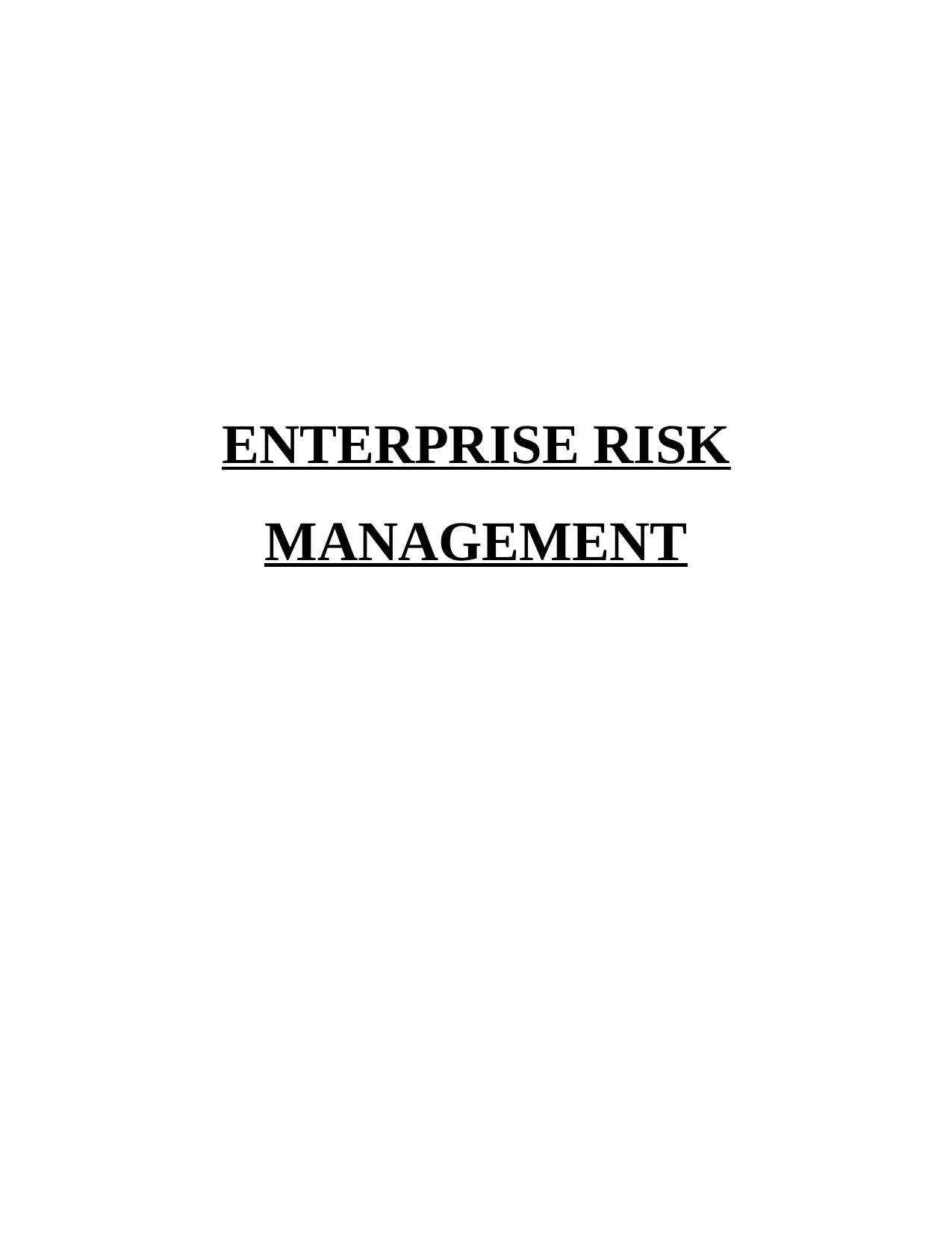
ENTERPRISE RISK
MANAGEMENT
MANAGEMENT
Paraphrase This Document
Need a fresh take? Get an instant paraphrase of this document with our AI Paraphraser
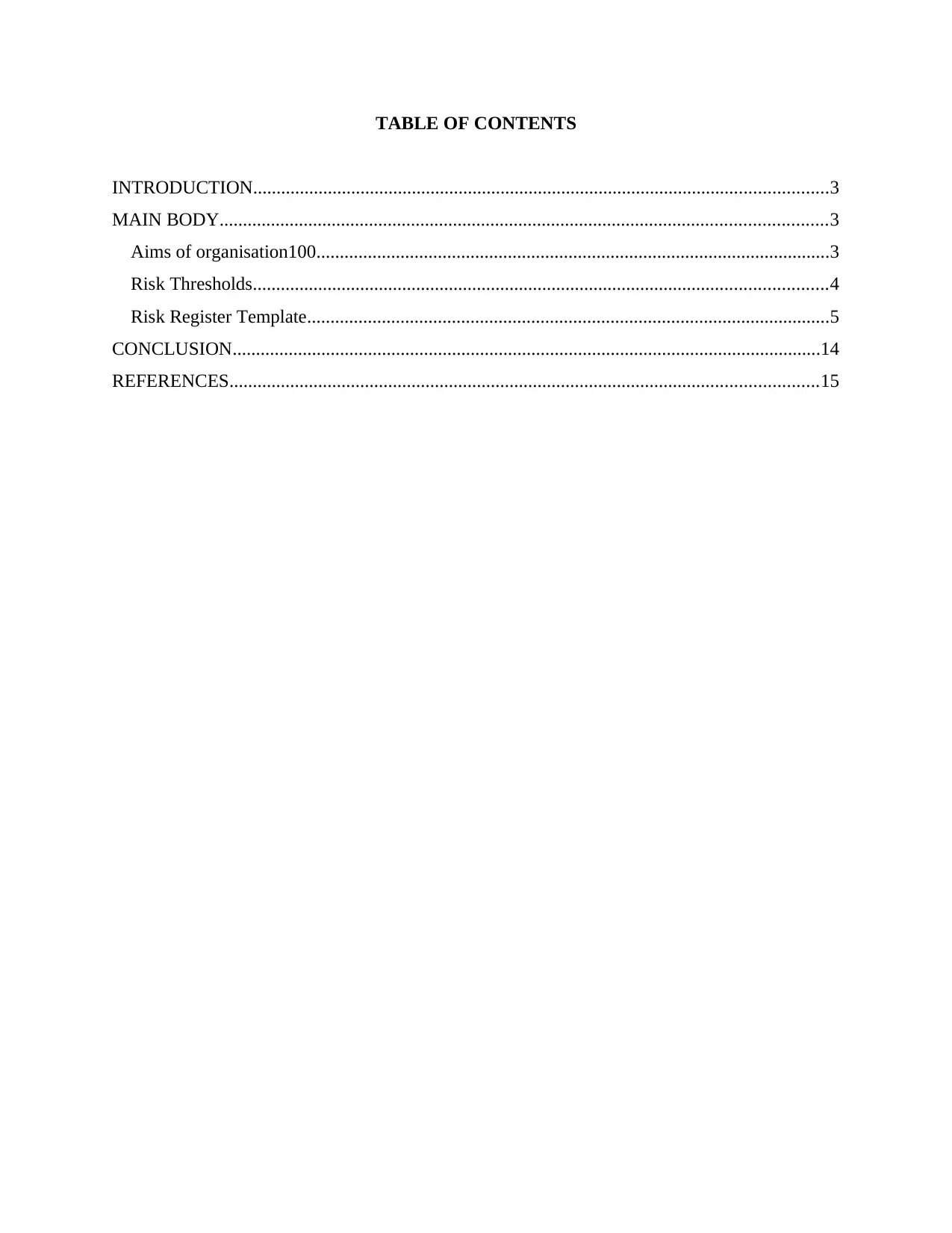
TABLE OF CONTENTS
INTRODUCTION...........................................................................................................................3
MAIN BODY..................................................................................................................................3
Aims of organisation100..............................................................................................................3
Risk Thresholds...........................................................................................................................4
Risk Register Template................................................................................................................5
CONCLUSION..............................................................................................................................14
REFERENCES..............................................................................................................................15
INTRODUCTION...........................................................................................................................3
MAIN BODY..................................................................................................................................3
Aims of organisation100..............................................................................................................3
Risk Thresholds...........................................................................................................................4
Risk Register Template................................................................................................................5
CONCLUSION..............................................................................................................................14
REFERENCES..............................................................................................................................15
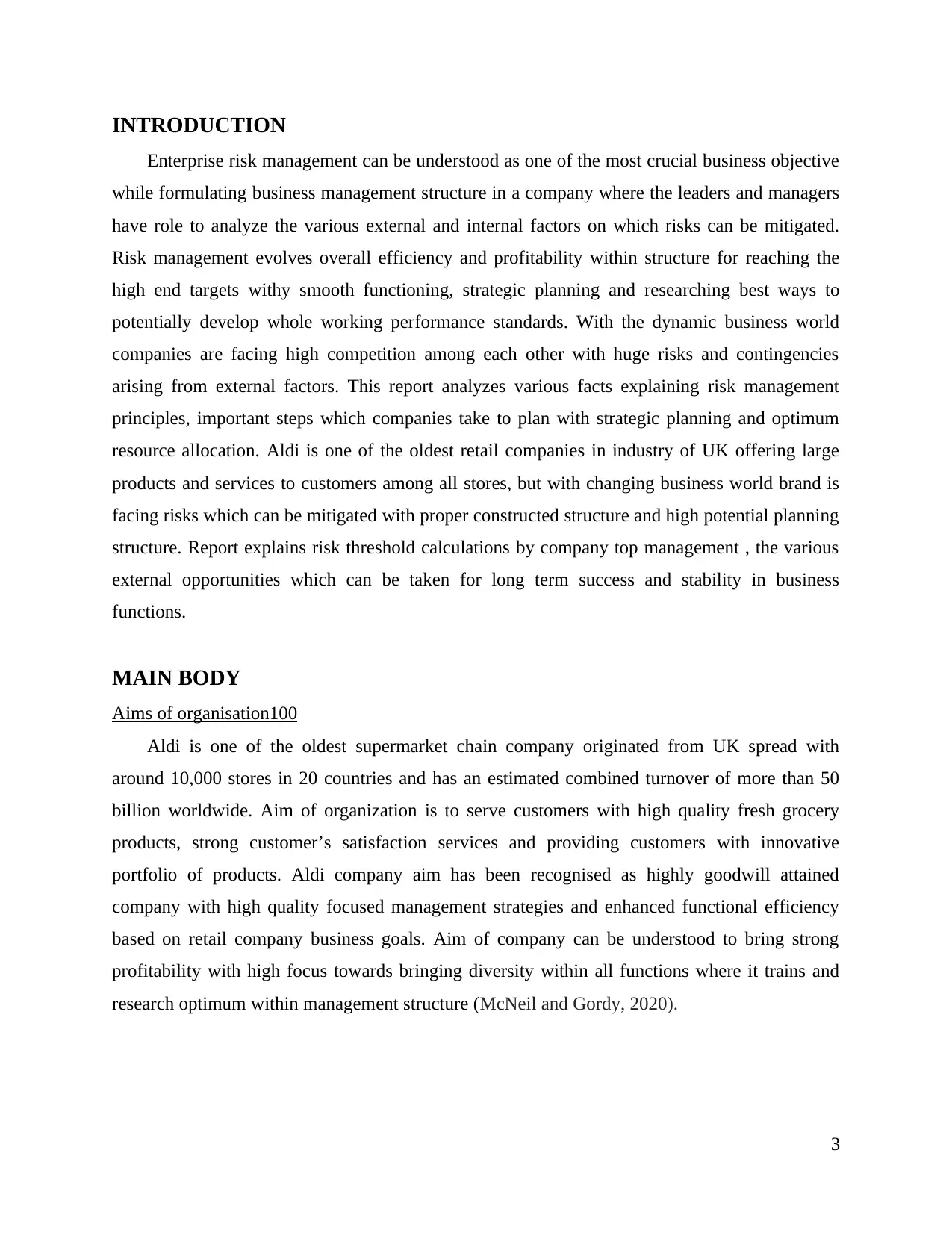
INTRODUCTION
Enterprise risk management can be understood as one of the most crucial business objective
while formulating business management structure in a company where the leaders and managers
have role to analyze the various external and internal factors on which risks can be mitigated.
Risk management evolves overall efficiency and profitability within structure for reaching the
high end targets withy smooth functioning, strategic planning and researching best ways to
potentially develop whole working performance standards. With the dynamic business world
companies are facing high competition among each other with huge risks and contingencies
arising from external factors. This report analyzes various facts explaining risk management
principles, important steps which companies take to plan with strategic planning and optimum
resource allocation. Aldi is one of the oldest retail companies in industry of UK offering large
products and services to customers among all stores, but with changing business world brand is
facing risks which can be mitigated with proper constructed structure and high potential planning
structure. Report explains risk threshold calculations by company top management , the various
external opportunities which can be taken for long term success and stability in business
functions.
MAIN BODY
Aims of organisation100
Aldi is one of the oldest supermarket chain company originated from UK spread with
around 10,000 stores in 20 countries and has an estimated combined turnover of more than 50
billion worldwide. Aim of organization is to serve customers with high quality fresh grocery
products, strong customer’s satisfaction services and providing customers with innovative
portfolio of products. Aldi company aim has been recognised as highly goodwill attained
company with high quality focused management strategies and enhanced functional efficiency
based on retail company business goals. Aim of company can be understood to bring strong
profitability with high focus towards bringing diversity within all functions where it trains and
research optimum within management structure (McNeil and Gordy, 2020).
3
Enterprise risk management can be understood as one of the most crucial business objective
while formulating business management structure in a company where the leaders and managers
have role to analyze the various external and internal factors on which risks can be mitigated.
Risk management evolves overall efficiency and profitability within structure for reaching the
high end targets withy smooth functioning, strategic planning and researching best ways to
potentially develop whole working performance standards. With the dynamic business world
companies are facing high competition among each other with huge risks and contingencies
arising from external factors. This report analyzes various facts explaining risk management
principles, important steps which companies take to plan with strategic planning and optimum
resource allocation. Aldi is one of the oldest retail companies in industry of UK offering large
products and services to customers among all stores, but with changing business world brand is
facing risks which can be mitigated with proper constructed structure and high potential planning
structure. Report explains risk threshold calculations by company top management , the various
external opportunities which can be taken for long term success and stability in business
functions.
MAIN BODY
Aims of organisation100
Aldi is one of the oldest supermarket chain company originated from UK spread with
around 10,000 stores in 20 countries and has an estimated combined turnover of more than 50
billion worldwide. Aim of organization is to serve customers with high quality fresh grocery
products, strong customer’s satisfaction services and providing customers with innovative
portfolio of products. Aldi company aim has been recognised as highly goodwill attained
company with high quality focused management strategies and enhanced functional efficiency
based on retail company business goals. Aim of company can be understood to bring strong
profitability with high focus towards bringing diversity within all functions where it trains and
research optimum within management structure (McNeil and Gordy, 2020).
3
⊘ This is a preview!⊘
Do you want full access?
Subscribe today to unlock all pages.

Trusted by 1+ million students worldwide
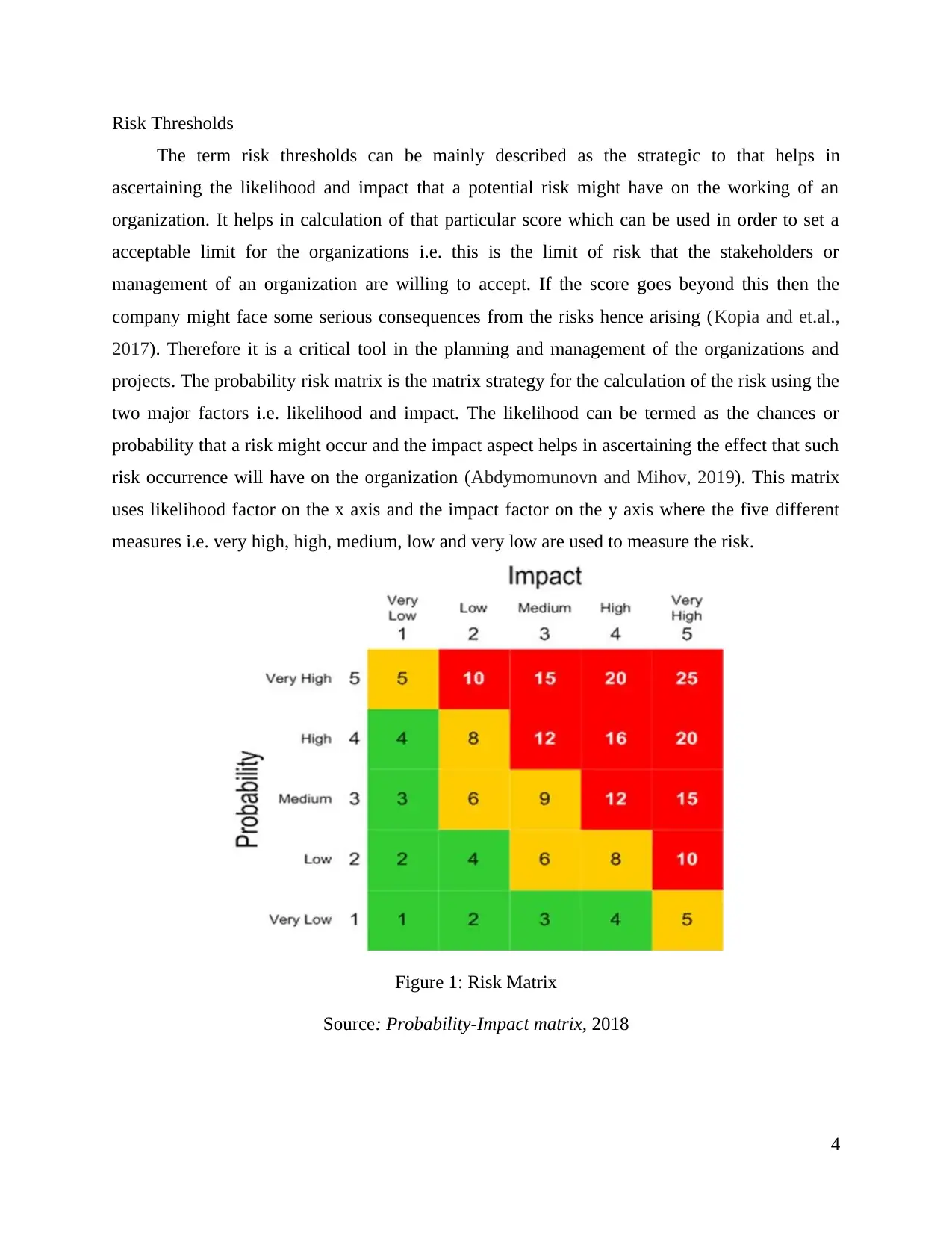
Risk Thresholds
The term risk thresholds can be mainly described as the strategic to that helps in
ascertaining the likelihood and impact that a potential risk might have on the working of an
organization. It helps in calculation of that particular score which can be used in order to set a
acceptable limit for the organizations i.e. this is the limit of risk that the stakeholders or
management of an organization are willing to accept. If the score goes beyond this then the
company might face some serious consequences from the risks hence arising (Kopia and et.al.,
2017). Therefore it is a critical tool in the planning and management of the organizations and
projects. The probability risk matrix is the matrix strategy for the calculation of the risk using the
two major factors i.e. likelihood and impact. The likelihood can be termed as the chances or
probability that a risk might occur and the impact aspect helps in ascertaining the effect that such
risk occurrence will have on the organization (Abdymomunovn and Mihov, 2019). This matrix
uses likelihood factor on the x axis and the impact factor on the y axis where the five different
measures i.e. very high, high, medium, low and very low are used to measure the risk.
Figure 1: Risk Matrix
Source: Probability-Impact matrix, 2018
4
The term risk thresholds can be mainly described as the strategic to that helps in
ascertaining the likelihood and impact that a potential risk might have on the working of an
organization. It helps in calculation of that particular score which can be used in order to set a
acceptable limit for the organizations i.e. this is the limit of risk that the stakeholders or
management of an organization are willing to accept. If the score goes beyond this then the
company might face some serious consequences from the risks hence arising (Kopia and et.al.,
2017). Therefore it is a critical tool in the planning and management of the organizations and
projects. The probability risk matrix is the matrix strategy for the calculation of the risk using the
two major factors i.e. likelihood and impact. The likelihood can be termed as the chances or
probability that a risk might occur and the impact aspect helps in ascertaining the effect that such
risk occurrence will have on the organization (Abdymomunovn and Mihov, 2019). This matrix
uses likelihood factor on the x axis and the impact factor on the y axis where the five different
measures i.e. very high, high, medium, low and very low are used to measure the risk.
Figure 1: Risk Matrix
Source: Probability-Impact matrix, 2018
4
Paraphrase This Document
Need a fresh take? Get an instant paraphrase of this document with our AI Paraphraser
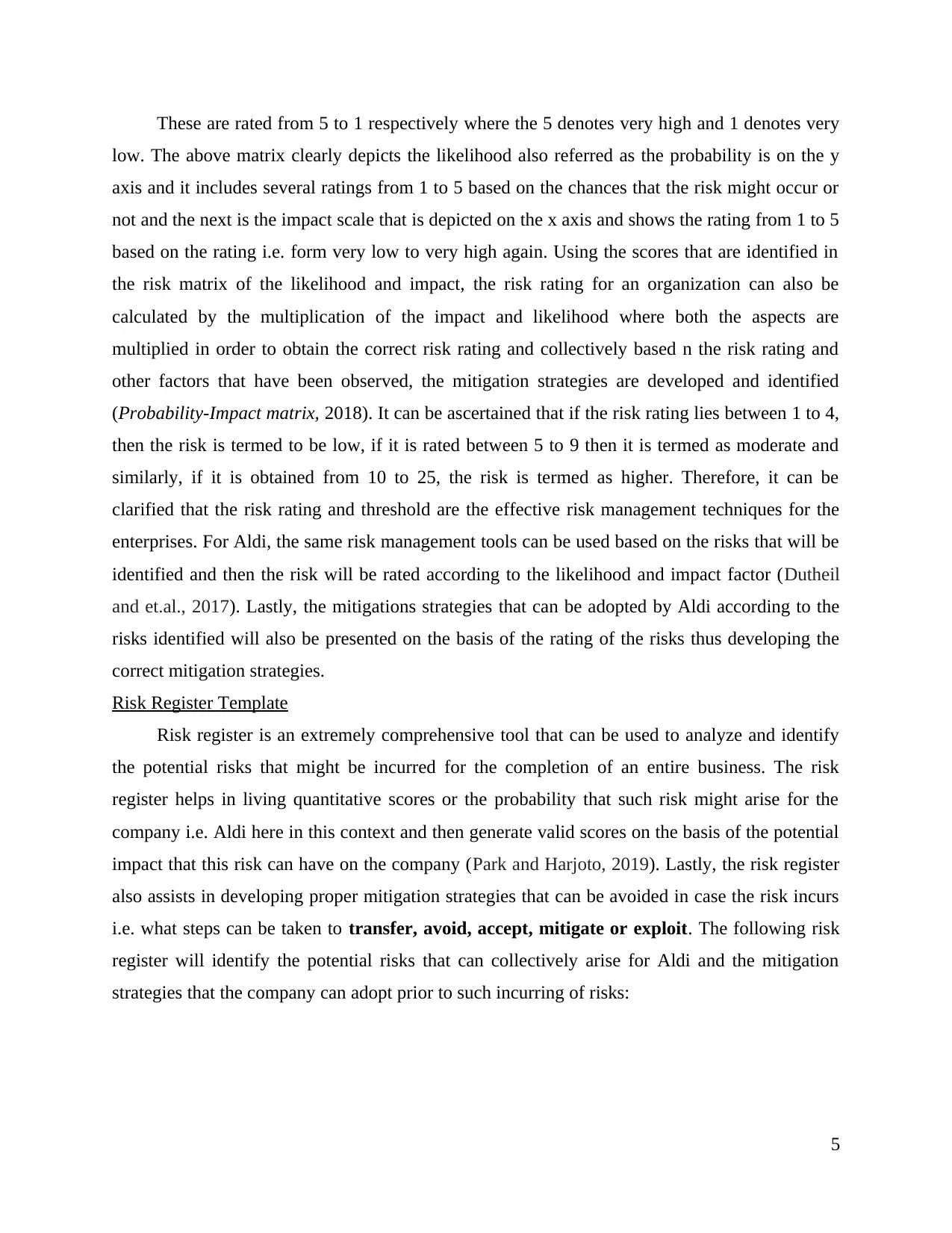
These are rated from 5 to 1 respectively where the 5 denotes very high and 1 denotes very
low. The above matrix clearly depicts the likelihood also referred as the probability is on the y
axis and it includes several ratings from 1 to 5 based on the chances that the risk might occur or
not and the next is the impact scale that is depicted on the x axis and shows the rating from 1 to 5
based on the rating i.e. form very low to very high again. Using the scores that are identified in
the risk matrix of the likelihood and impact, the risk rating for an organization can also be
calculated by the multiplication of the impact and likelihood where both the aspects are
multiplied in order to obtain the correct risk rating and collectively based n the risk rating and
other factors that have been observed, the mitigation strategies are developed and identified
(Probability-Impact matrix, 2018). It can be ascertained that if the risk rating lies between 1 to 4,
then the risk is termed to be low, if it is rated between 5 to 9 then it is termed as moderate and
similarly, if it is obtained from 10 to 25, the risk is termed as higher. Therefore, it can be
clarified that the risk rating and threshold are the effective risk management techniques for the
enterprises. For Aldi, the same risk management tools can be used based on the risks that will be
identified and then the risk will be rated according to the likelihood and impact factor (Dutheil
and et.al., 2017). Lastly, the mitigations strategies that can be adopted by Aldi according to the
risks identified will also be presented on the basis of the rating of the risks thus developing the
correct mitigation strategies.
Risk Register Template
Risk register is an extremely comprehensive tool that can be used to analyze and identify
the potential risks that might be incurred for the completion of an entire business. The risk
register helps in living quantitative scores or the probability that such risk might arise for the
company i.e. Aldi here in this context and then generate valid scores on the basis of the potential
impact that this risk can have on the company (Park and Harjoto, 2019). Lastly, the risk register
also assists in developing proper mitigation strategies that can be avoided in case the risk incurs
i.e. what steps can be taken to transfer, avoid, accept, mitigate or exploit. The following risk
register will identify the potential risks that can collectively arise for Aldi and the mitigation
strategies that the company can adopt prior to such incurring of risks:
5
low. The above matrix clearly depicts the likelihood also referred as the probability is on the y
axis and it includes several ratings from 1 to 5 based on the chances that the risk might occur or
not and the next is the impact scale that is depicted on the x axis and shows the rating from 1 to 5
based on the rating i.e. form very low to very high again. Using the scores that are identified in
the risk matrix of the likelihood and impact, the risk rating for an organization can also be
calculated by the multiplication of the impact and likelihood where both the aspects are
multiplied in order to obtain the correct risk rating and collectively based n the risk rating and
other factors that have been observed, the mitigation strategies are developed and identified
(Probability-Impact matrix, 2018). It can be ascertained that if the risk rating lies between 1 to 4,
then the risk is termed to be low, if it is rated between 5 to 9 then it is termed as moderate and
similarly, if it is obtained from 10 to 25, the risk is termed as higher. Therefore, it can be
clarified that the risk rating and threshold are the effective risk management techniques for the
enterprises. For Aldi, the same risk management tools can be used based on the risks that will be
identified and then the risk will be rated according to the likelihood and impact factor (Dutheil
and et.al., 2017). Lastly, the mitigations strategies that can be adopted by Aldi according to the
risks identified will also be presented on the basis of the rating of the risks thus developing the
correct mitigation strategies.
Risk Register Template
Risk register is an extremely comprehensive tool that can be used to analyze and identify
the potential risks that might be incurred for the completion of an entire business. The risk
register helps in living quantitative scores or the probability that such risk might arise for the
company i.e. Aldi here in this context and then generate valid scores on the basis of the potential
impact that this risk can have on the company (Park and Harjoto, 2019). Lastly, the risk register
also assists in developing proper mitigation strategies that can be avoided in case the risk incurs
i.e. what steps can be taken to transfer, avoid, accept, mitigate or exploit. The following risk
register will identify the potential risks that can collectively arise for Aldi and the mitigation
strategies that the company can adopt prior to such incurring of risks:
5
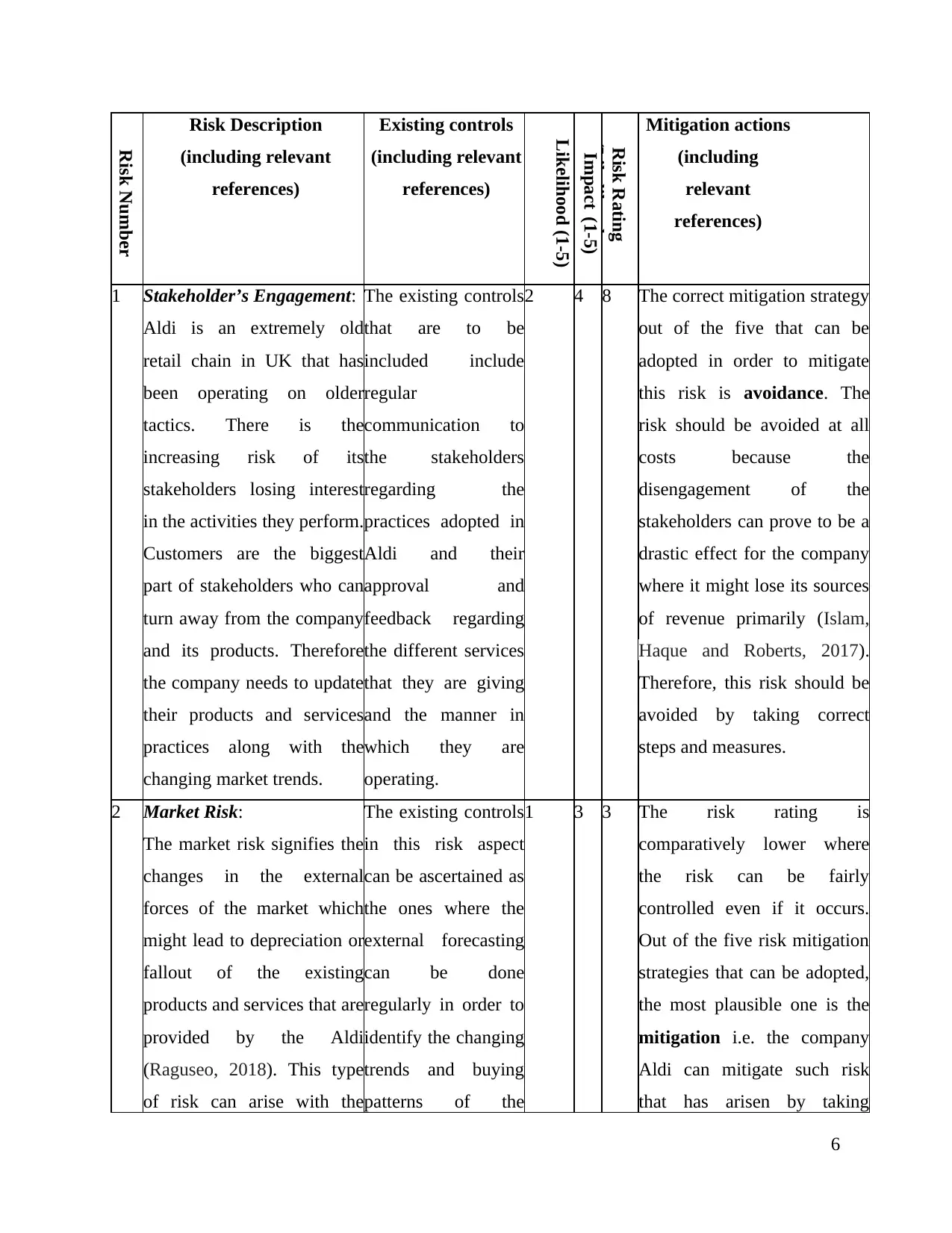
Risk Number
Risk Description
(including relevant
references)
Existing controls
(including relevant
references)
Likelihood (1-5)
Impact (1-5)
Risk Rating
(Likelihood x
Mitigation actions
(including
relevant
references)
1 Stakeholder’s Engagement:
Aldi is an extremely old
retail chain in UK that has
been operating on older
tactics. There is the
increasing risk of its
stakeholders losing interest
in the activities they perform.
Customers are the biggest
part of stakeholders who can
turn away from the company
and its products. Therefore
the company needs to update
their products and services
practices along with the
changing market trends.
The existing controls
that are to be
included include
regular
communication to
the stakeholders
regarding the
practices adopted in
Aldi and their
approval and
feedback regarding
the different services
that they are giving
and the manner in
which they are
operating.
2 4 8 The correct mitigation strategy
out of the five that can be
adopted in order to mitigate
this risk is avoidance. The
risk should be avoided at all
costs because the
disengagement of the
stakeholders can prove to be a
drastic effect for the company
where it might lose its sources
of revenue primarily (Islam,
Haque and Roberts, 2017).
Therefore, this risk should be
avoided by taking correct
steps and measures.
2 Market Risk:
The market risk signifies the
changes in the external
forces of the market which
might lead to depreciation or
fallout of the existing
products and services that are
provided by the Aldi
(Raguseo, 2018). This type
of risk can arise with the
The existing controls
in this risk aspect
can be ascertained as
the ones where the
external forecasting
can be done
regularly in order to
identify the changing
trends and buying
patterns of the
1 3 3 The risk rating is
comparatively lower where
the risk can be fairly
controlled even if it occurs.
Out of the five risk mitigation
strategies that can be adopted,
the most plausible one is the
mitigation i.e. the company
Aldi can mitigate such risk
that has arisen by taking
6
Risk Description
(including relevant
references)
Existing controls
(including relevant
references)
Likelihood (1-5)
Impact (1-5)
Risk Rating
(Likelihood x
Mitigation actions
(including
relevant
references)
1 Stakeholder’s Engagement:
Aldi is an extremely old
retail chain in UK that has
been operating on older
tactics. There is the
increasing risk of its
stakeholders losing interest
in the activities they perform.
Customers are the biggest
part of stakeholders who can
turn away from the company
and its products. Therefore
the company needs to update
their products and services
practices along with the
changing market trends.
The existing controls
that are to be
included include
regular
communication to
the stakeholders
regarding the
practices adopted in
Aldi and their
approval and
feedback regarding
the different services
that they are giving
and the manner in
which they are
operating.
2 4 8 The correct mitigation strategy
out of the five that can be
adopted in order to mitigate
this risk is avoidance. The
risk should be avoided at all
costs because the
disengagement of the
stakeholders can prove to be a
drastic effect for the company
where it might lose its sources
of revenue primarily (Islam,
Haque and Roberts, 2017).
Therefore, this risk should be
avoided by taking correct
steps and measures.
2 Market Risk:
The market risk signifies the
changes in the external
forces of the market which
might lead to depreciation or
fallout of the existing
products and services that are
provided by the Aldi
(Raguseo, 2018). This type
of risk can arise with the
The existing controls
in this risk aspect
can be ascertained as
the ones where the
external forecasting
can be done
regularly in order to
identify the changing
trends and buying
patterns of the
1 3 3 The risk rating is
comparatively lower where
the risk can be fairly
controlled even if it occurs.
Out of the five risk mitigation
strategies that can be adopted,
the most plausible one is the
mitigation i.e. the company
Aldi can mitigate such risk
that has arisen by taking
6
⊘ This is a preview!⊘
Do you want full access?
Subscribe today to unlock all pages.

Trusted by 1+ million students worldwide
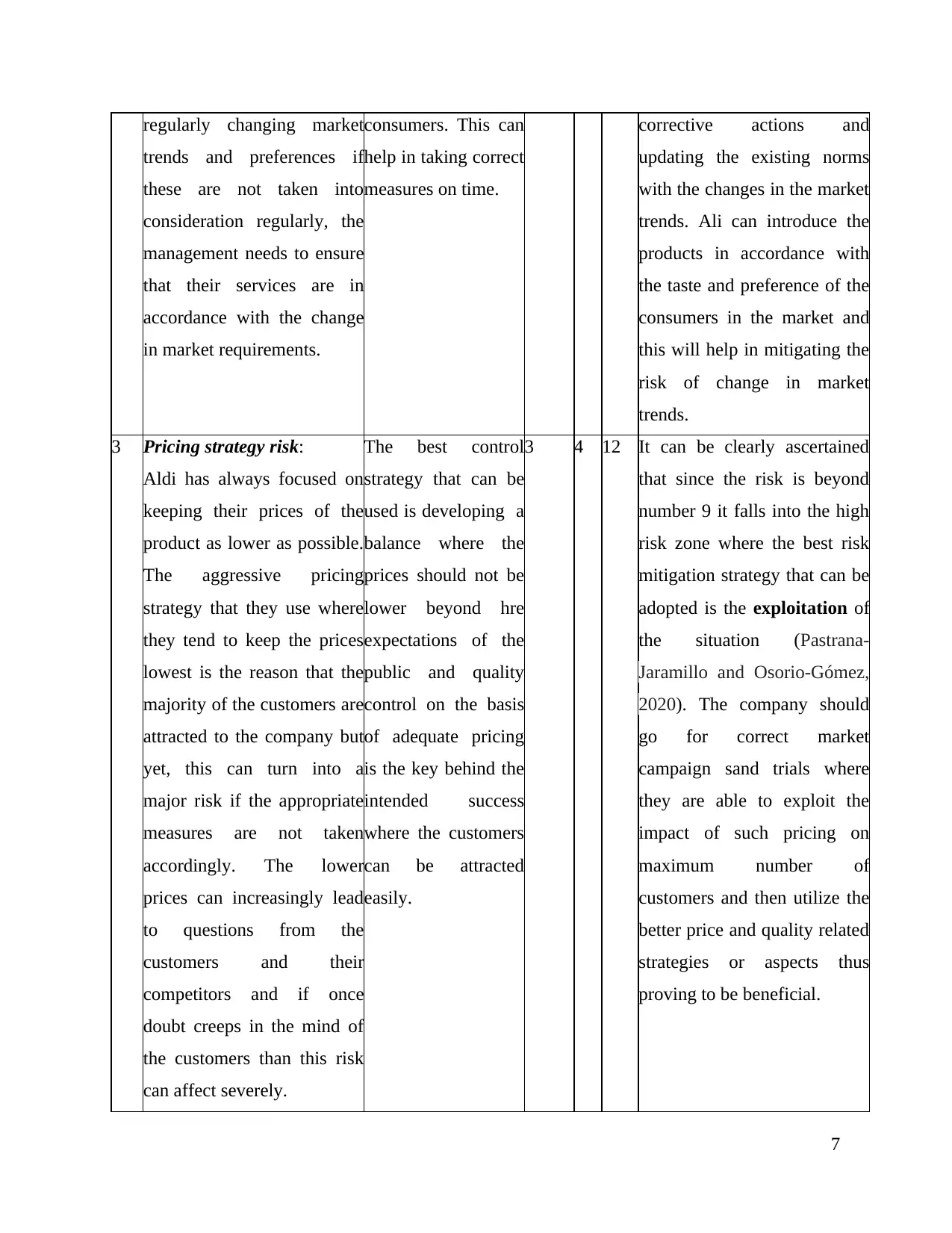
regularly changing market
trends and preferences if
these are not taken into
consideration regularly, the
management needs to ensure
that their services are in
accordance with the change
in market requirements.
consumers. This can
help in taking correct
measures on time.
corrective actions and
updating the existing norms
with the changes in the market
trends. Ali can introduce the
products in accordance with
the taste and preference of the
consumers in the market and
this will help in mitigating the
risk of change in market
trends.
3 Pricing strategy risk:
Aldi has always focused on
keeping their prices of the
product as lower as possible.
The aggressive pricing
strategy that they use where
they tend to keep the prices
lowest is the reason that the
majority of the customers are
attracted to the company but
yet, this can turn into a
major risk if the appropriate
measures are not taken
accordingly. The lower
prices can increasingly lead
to questions from the
customers and their
competitors and if once
doubt creeps in the mind of
the customers than this risk
can affect severely.
The best control
strategy that can be
used is developing a
balance where the
prices should not be
lower beyond hre
expectations of the
public and quality
control on the basis
of adequate pricing
is the key behind the
intended success
where the customers
can be attracted
easily.
3 4 12 It can be clearly ascertained
that since the risk is beyond
number 9 it falls into the high
risk zone where the best risk
mitigation strategy that can be
adopted is the exploitation of
the situation (Pastrana-
Jaramillo and Osorio-Gómez,
2020). The company should
go for correct market
campaign sand trials where
they are able to exploit the
impact of such pricing on
maximum number of
customers and then utilize the
better price and quality related
strategies or aspects thus
proving to be beneficial.
7
trends and preferences if
these are not taken into
consideration regularly, the
management needs to ensure
that their services are in
accordance with the change
in market requirements.
consumers. This can
help in taking correct
measures on time.
corrective actions and
updating the existing norms
with the changes in the market
trends. Ali can introduce the
products in accordance with
the taste and preference of the
consumers in the market and
this will help in mitigating the
risk of change in market
trends.
3 Pricing strategy risk:
Aldi has always focused on
keeping their prices of the
product as lower as possible.
The aggressive pricing
strategy that they use where
they tend to keep the prices
lowest is the reason that the
majority of the customers are
attracted to the company but
yet, this can turn into a
major risk if the appropriate
measures are not taken
accordingly. The lower
prices can increasingly lead
to questions from the
customers and their
competitors and if once
doubt creeps in the mind of
the customers than this risk
can affect severely.
The best control
strategy that can be
used is developing a
balance where the
prices should not be
lower beyond hre
expectations of the
public and quality
control on the basis
of adequate pricing
is the key behind the
intended success
where the customers
can be attracted
easily.
3 4 12 It can be clearly ascertained
that since the risk is beyond
number 9 it falls into the high
risk zone where the best risk
mitigation strategy that can be
adopted is the exploitation of
the situation (Pastrana-
Jaramillo and Osorio-Gómez,
2020). The company should
go for correct market
campaign sand trials where
they are able to exploit the
impact of such pricing on
maximum number of
customers and then utilize the
better price and quality related
strategies or aspects thus
proving to be beneficial.
7
Paraphrase This Document
Need a fresh take? Get an instant paraphrase of this document with our AI Paraphraser
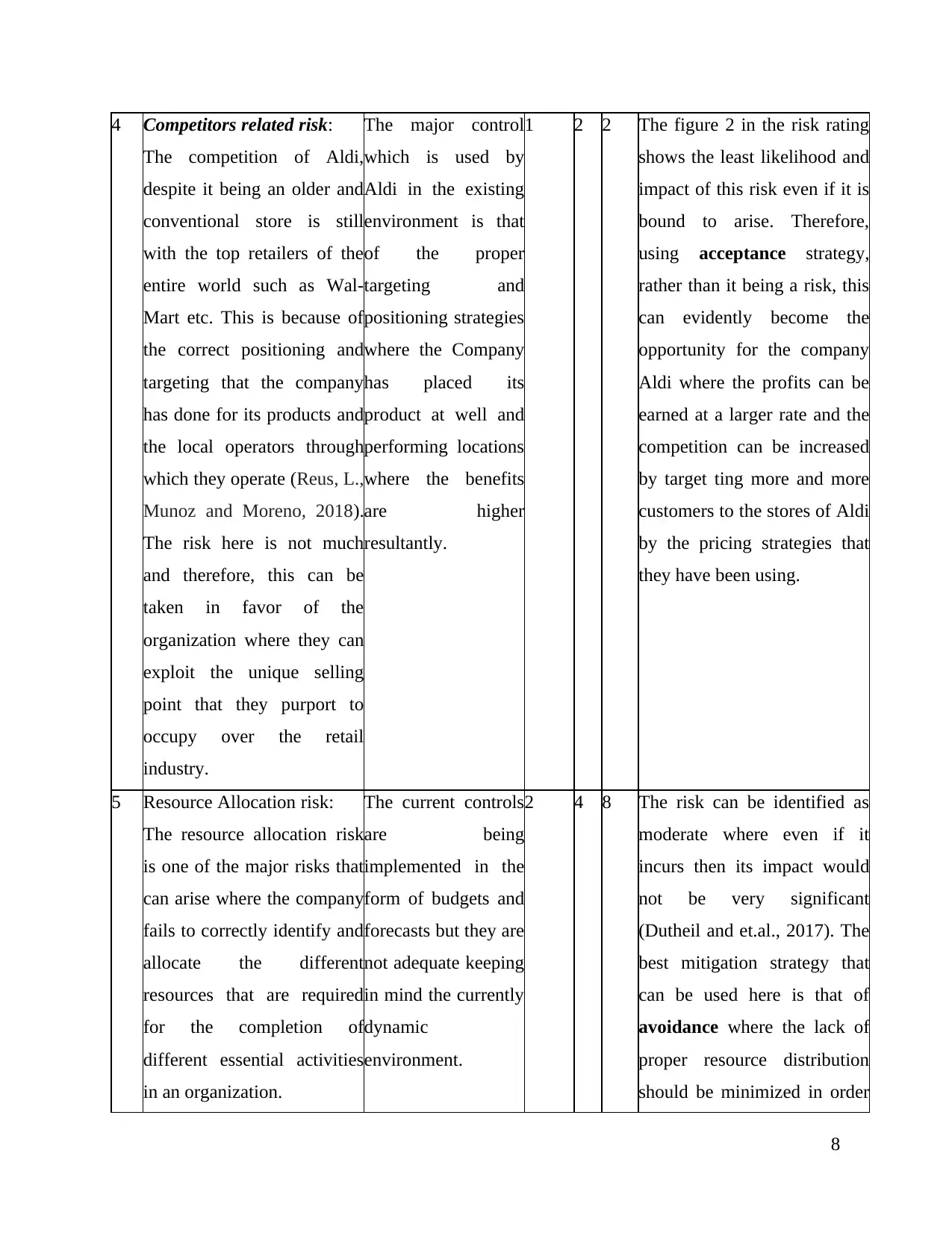
4 Competitors related risk:
The competition of Aldi,
despite it being an older and
conventional store is still
with the top retailers of the
entire world such as Wal-
Mart etc. This is because of
the correct positioning and
targeting that the company
has done for its products and
the local operators through
which they operate (Reus, L.,
Munoz and Moreno, 2018).
The risk here is not much
and therefore, this can be
taken in favor of the
organization where they can
exploit the unique selling
point that they purport to
occupy over the retail
industry.
The major control
which is used by
Aldi in the existing
environment is that
of the proper
targeting and
positioning strategies
where the Company
has placed its
product at well and
performing locations
where the benefits
are higher
resultantly.
1 2 2 The figure 2 in the risk rating
shows the least likelihood and
impact of this risk even if it is
bound to arise. Therefore,
using acceptance strategy,
rather than it being a risk, this
can evidently become the
opportunity for the company
Aldi where the profits can be
earned at a larger rate and the
competition can be increased
by target ting more and more
customers to the stores of Aldi
by the pricing strategies that
they have been using.
5 Resource Allocation risk:
The resource allocation risk
is one of the major risks that
can arise where the company
fails to correctly identify and
allocate the different
resources that are required
for the completion of
different essential activities
in an organization.
The current controls
are being
implemented in the
form of budgets and
forecasts but they are
not adequate keeping
in mind the currently
dynamic
environment.
2 4 8 The risk can be identified as
moderate where even if it
incurs then its impact would
not be very significant
(Dutheil and et.al., 2017). The
best mitigation strategy that
can be used here is that of
avoidance where the lack of
proper resource distribution
should be minimized in order
8
The competition of Aldi,
despite it being an older and
conventional store is still
with the top retailers of the
entire world such as Wal-
Mart etc. This is because of
the correct positioning and
targeting that the company
has done for its products and
the local operators through
which they operate (Reus, L.,
Munoz and Moreno, 2018).
The risk here is not much
and therefore, this can be
taken in favor of the
organization where they can
exploit the unique selling
point that they purport to
occupy over the retail
industry.
The major control
which is used by
Aldi in the existing
environment is that
of the proper
targeting and
positioning strategies
where the Company
has placed its
product at well and
performing locations
where the benefits
are higher
resultantly.
1 2 2 The figure 2 in the risk rating
shows the least likelihood and
impact of this risk even if it is
bound to arise. Therefore,
using acceptance strategy,
rather than it being a risk, this
can evidently become the
opportunity for the company
Aldi where the profits can be
earned at a larger rate and the
competition can be increased
by target ting more and more
customers to the stores of Aldi
by the pricing strategies that
they have been using.
5 Resource Allocation risk:
The resource allocation risk
is one of the major risks that
can arise where the company
fails to correctly identify and
allocate the different
resources that are required
for the completion of
different essential activities
in an organization.
The current controls
are being
implemented in the
form of budgets and
forecasts but they are
not adequate keeping
in mind the currently
dynamic
environment.
2 4 8 The risk can be identified as
moderate where even if it
incurs then its impact would
not be very significant
(Dutheil and et.al., 2017). The
best mitigation strategy that
can be used here is that of
avoidance where the lack of
proper resource distribution
should be minimized in order
8
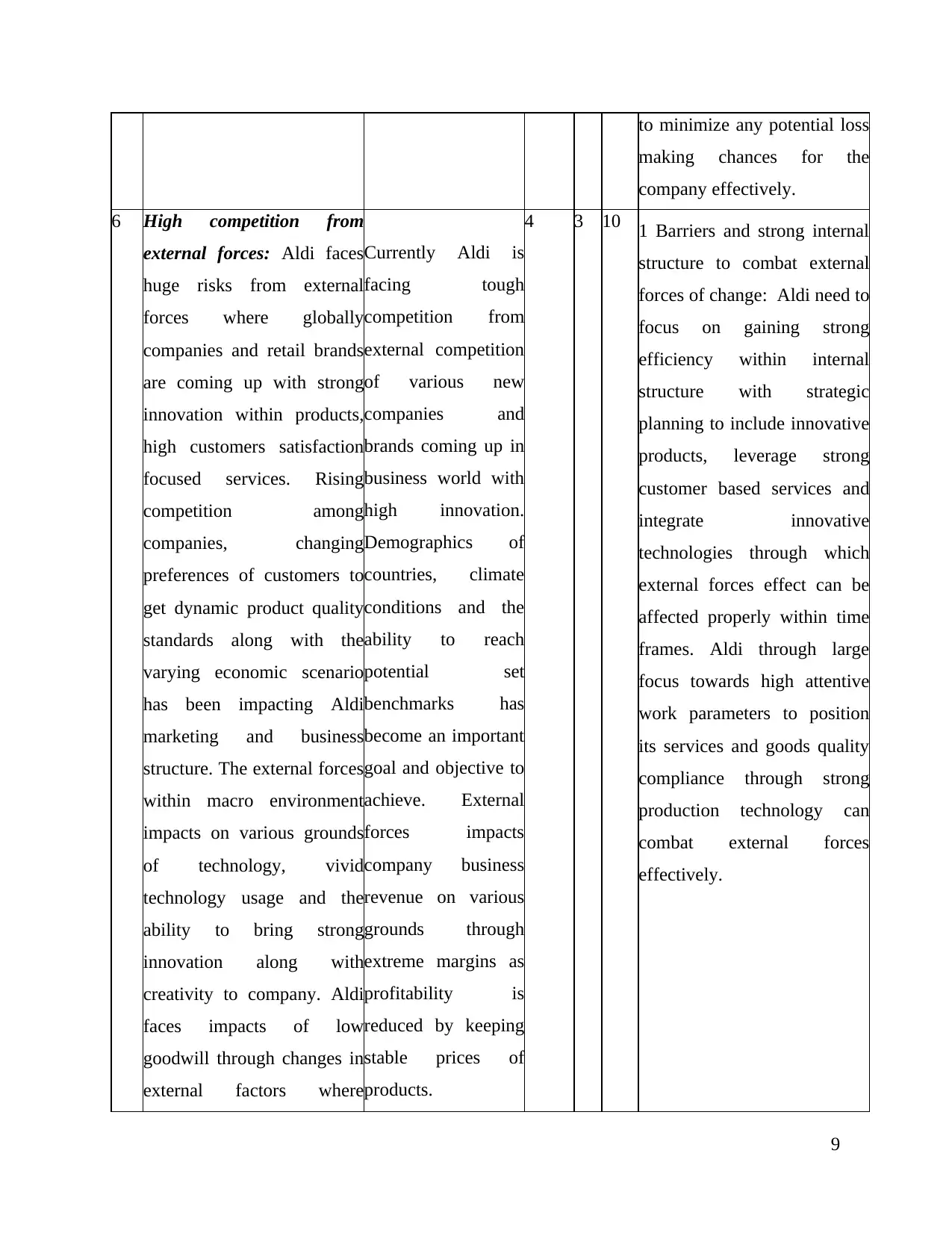
to minimize any potential loss
making chances for the
company effectively.
6 High competition from
external forces: Aldi faces
huge risks from external
forces where globally
companies and retail brands
are coming up with strong
innovation within products,
high customers satisfaction
focused services. Rising
competition among
companies, changing
preferences of customers to
get dynamic product quality
standards along with the
varying economic scenario
has been impacting Aldi
marketing and business
structure. The external forces
within macro environment
impacts on various grounds
of technology, vivid
technology usage and the
ability to bring strong
innovation along with
creativity to company. Aldi
faces impacts of low
goodwill through changes in
external factors where
Currently Aldi is
facing tough
competition from
external competition
of various new
companies and
brands coming up in
business world with
high innovation.
Demographics of
countries, climate
conditions and the
ability to reach
potential set
benchmarks has
become an important
goal and objective to
achieve. External
forces impacts
company business
revenue on various
grounds through
extreme margins as
profitability is
reduced by keeping
stable prices of
products.
4 3 10 1 Barriers and strong internal
structure to combat external
forces of change: Aldi need to
focus on gaining strong
efficiency within internal
structure with strategic
planning to include innovative
products, leverage strong
customer based services and
integrate innovative
technologies through which
external forces effect can be
affected properly within time
frames. Aldi through large
focus towards high attentive
work parameters to position
its services and goods quality
compliance through strong
production technology can
combat external forces
effectively.
9
making chances for the
company effectively.
6 High competition from
external forces: Aldi faces
huge risks from external
forces where globally
companies and retail brands
are coming up with strong
innovation within products,
high customers satisfaction
focused services. Rising
competition among
companies, changing
preferences of customers to
get dynamic product quality
standards along with the
varying economic scenario
has been impacting Aldi
marketing and business
structure. The external forces
within macro environment
impacts on various grounds
of technology, vivid
technology usage and the
ability to bring strong
innovation along with
creativity to company. Aldi
faces impacts of low
goodwill through changes in
external factors where
Currently Aldi is
facing tough
competition from
external competition
of various new
companies and
brands coming up in
business world with
high innovation.
Demographics of
countries, climate
conditions and the
ability to reach
potential set
benchmarks has
become an important
goal and objective to
achieve. External
forces impacts
company business
revenue on various
grounds through
extreme margins as
profitability is
reduced by keeping
stable prices of
products.
4 3 10 1 Barriers and strong internal
structure to combat external
forces of change: Aldi need to
focus on gaining strong
efficiency within internal
structure with strategic
planning to include innovative
products, leverage strong
customer based services and
integrate innovative
technologies through which
external forces effect can be
affected properly within time
frames. Aldi through large
focus towards high attentive
work parameters to position
its services and goods quality
compliance through strong
production technology can
combat external forces
effectively.
9
⊘ This is a preview!⊘
Do you want full access?
Subscribe today to unlock all pages.

Trusted by 1+ million students worldwide
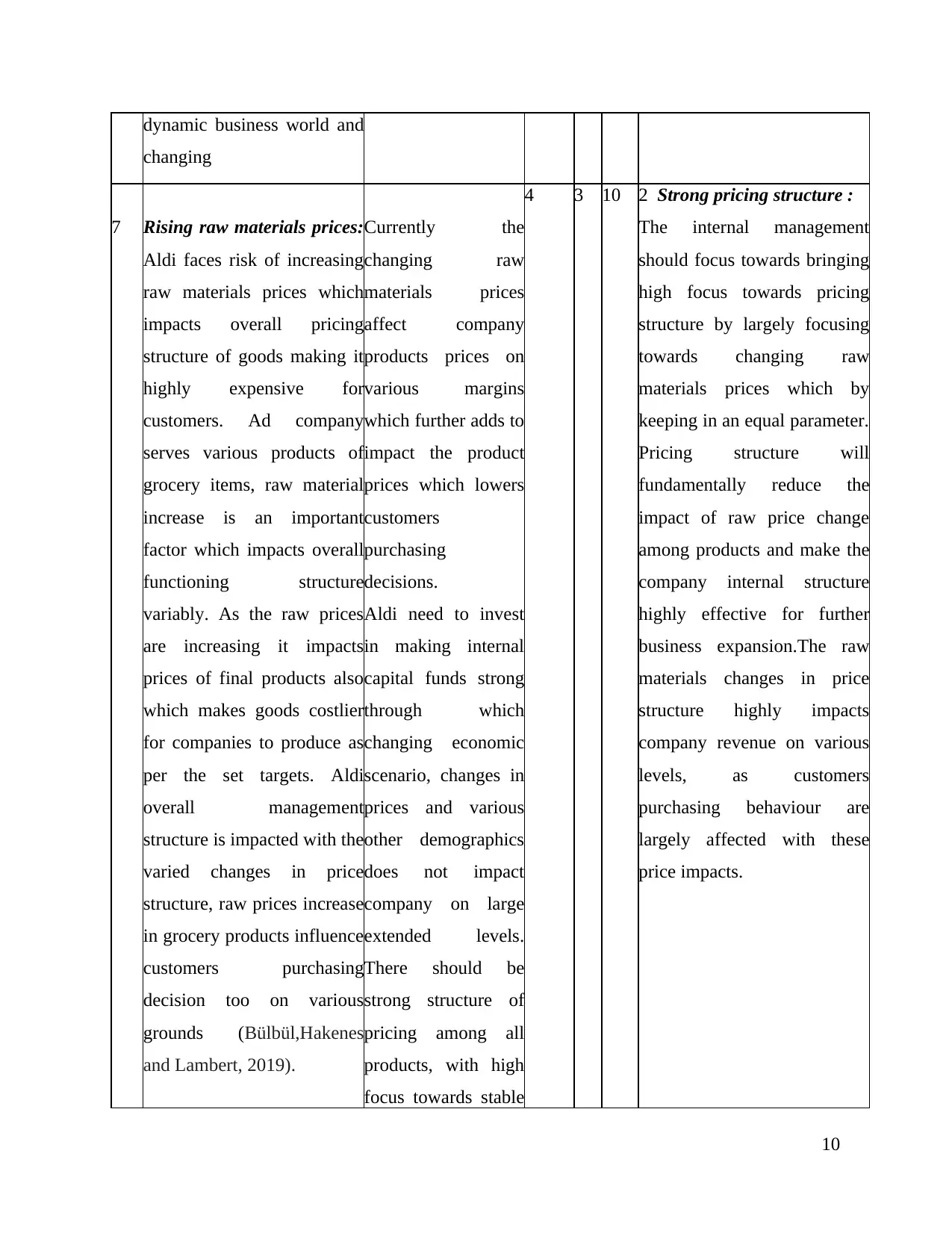
dynamic business world and
changing
7 Rising raw materials prices:
Aldi faces risk of increasing
raw materials prices which
impacts overall pricing
structure of goods making it
highly expensive for
customers. Ad company
serves various products of
grocery items, raw material
increase is an important
factor which impacts overall
functioning structure
variably. As the raw prices
are increasing it impacts
prices of final products also
which makes goods costlier
for companies to produce as
per the set targets. Aldi
overall management
structure is impacted with the
varied changes in price
structure, raw prices increase
in grocery products influence
customers purchasing
decision too on various
grounds (Bülbül,Hakenes
and Lambert, 2019).
Currently the
changing raw
materials prices
affect company
products prices on
various margins
which further adds to
impact the product
prices which lowers
customers
purchasing
decisions.
Aldi need to invest
in making internal
capital funds strong
through which
changing economic
scenario, changes in
prices and various
other demographics
does not impact
company on large
extended levels.
There should be
strong structure of
pricing among all
products, with high
focus towards stable
4 3 10 2 Strong pricing structure :
The internal management
should focus towards bringing
high focus towards pricing
structure by largely focusing
towards changing raw
materials prices which by
keeping in an equal parameter.
Pricing structure will
fundamentally reduce the
impact of raw price change
among products and make the
company internal structure
highly effective for further
business expansion.The raw
materials changes in price
structure highly impacts
company revenue on various
levels, as customers
purchasing behaviour are
largely affected with these
price impacts.
10
changing
7 Rising raw materials prices:
Aldi faces risk of increasing
raw materials prices which
impacts overall pricing
structure of goods making it
highly expensive for
customers. Ad company
serves various products of
grocery items, raw material
increase is an important
factor which impacts overall
functioning structure
variably. As the raw prices
are increasing it impacts
prices of final products also
which makes goods costlier
for companies to produce as
per the set targets. Aldi
overall management
structure is impacted with the
varied changes in price
structure, raw prices increase
in grocery products influence
customers purchasing
decision too on various
grounds (Bülbül,Hakenes
and Lambert, 2019).
Currently the
changing raw
materials prices
affect company
products prices on
various margins
which further adds to
impact the product
prices which lowers
customers
purchasing
decisions.
Aldi need to invest
in making internal
capital funds strong
through which
changing economic
scenario, changes in
prices and various
other demographics
does not impact
company on large
extended levels.
There should be
strong structure of
pricing among all
products, with high
focus towards stable
4 3 10 2 Strong pricing structure :
The internal management
should focus towards bringing
high focus towards pricing
structure by largely focusing
towards changing raw
materials prices which by
keeping in an equal parameter.
Pricing structure will
fundamentally reduce the
impact of raw price change
among products and make the
company internal structure
highly effective for further
business expansion.The raw
materials changes in price
structure highly impacts
company revenue on various
levels, as customers
purchasing behaviour are
largely affected with these
price impacts.
10
Paraphrase This Document
Need a fresh take? Get an instant paraphrase of this document with our AI Paraphraser
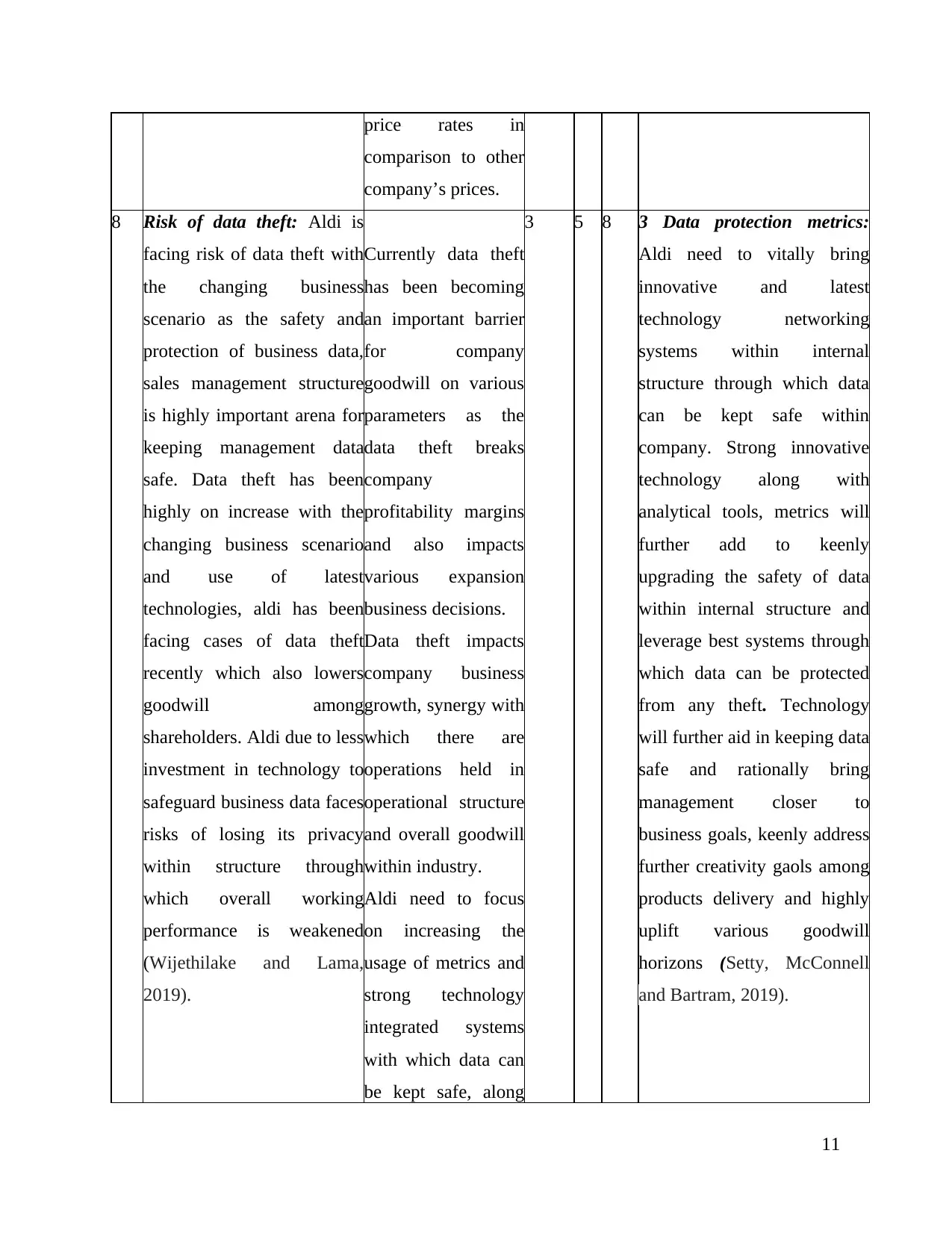
price rates in
comparison to other
company’s prices.
8 Risk of data theft: Aldi is
facing risk of data theft with
the changing business
scenario as the safety and
protection of business data,
sales management structure
is highly important arena for
keeping management data
safe. Data theft has been
highly on increase with the
changing business scenario
and use of latest
technologies, aldi has been
facing cases of data theft
recently which also lowers
goodwill among
shareholders. Aldi due to less
investment in technology to
safeguard business data faces
risks of losing its privacy
within structure through
which overall working
performance is weakened
(Wijethilake and Lama,
2019).
Currently data theft
has been becoming
an important barrier
for company
goodwill on various
parameters as the
data theft breaks
company
profitability margins
and also impacts
various expansion
business decisions.
Data theft impacts
company business
growth, synergy with
which there are
operations held in
operational structure
and overall goodwill
within industry.
Aldi need to focus
on increasing the
usage of metrics and
strong technology
integrated systems
with which data can
be kept safe, along
3 5 8 3 Data protection metrics:
Aldi need to vitally bring
innovative and latest
technology networking
systems within internal
structure through which data
can be kept safe within
company. Strong innovative
technology along with
analytical tools, metrics will
further add to keenly
upgrading the safety of data
within internal structure and
leverage best systems through
which data can be protected
from any theft. Technology
will further aid in keeping data
safe and rationally bring
management closer to
business goals, keenly address
further creativity gaols among
products delivery and highly
uplift various goodwill
horizons (Setty, McConnell
and Bartram, 2019).
11
comparison to other
company’s prices.
8 Risk of data theft: Aldi is
facing risk of data theft with
the changing business
scenario as the safety and
protection of business data,
sales management structure
is highly important arena for
keeping management data
safe. Data theft has been
highly on increase with the
changing business scenario
and use of latest
technologies, aldi has been
facing cases of data theft
recently which also lowers
goodwill among
shareholders. Aldi due to less
investment in technology to
safeguard business data faces
risks of losing its privacy
within structure through
which overall working
performance is weakened
(Wijethilake and Lama,
2019).
Currently data theft
has been becoming
an important barrier
for company
goodwill on various
parameters as the
data theft breaks
company
profitability margins
and also impacts
various expansion
business decisions.
Data theft impacts
company business
growth, synergy with
which there are
operations held in
operational structure
and overall goodwill
within industry.
Aldi need to focus
on increasing the
usage of metrics and
strong technology
integrated systems
with which data can
be kept safe, along
3 5 8 3 Data protection metrics:
Aldi need to vitally bring
innovative and latest
technology networking
systems within internal
structure through which data
can be kept safe within
company. Strong innovative
technology along with
analytical tools, metrics will
further add to keenly
upgrading the safety of data
within internal structure and
leverage best systems through
which data can be protected
from any theft. Technology
will further aid in keeping data
safe and rationally bring
management closer to
business goals, keenly address
further creativity gaols among
products delivery and highly
uplift various goodwill
horizons (Setty, McConnell
and Bartram, 2019).
11
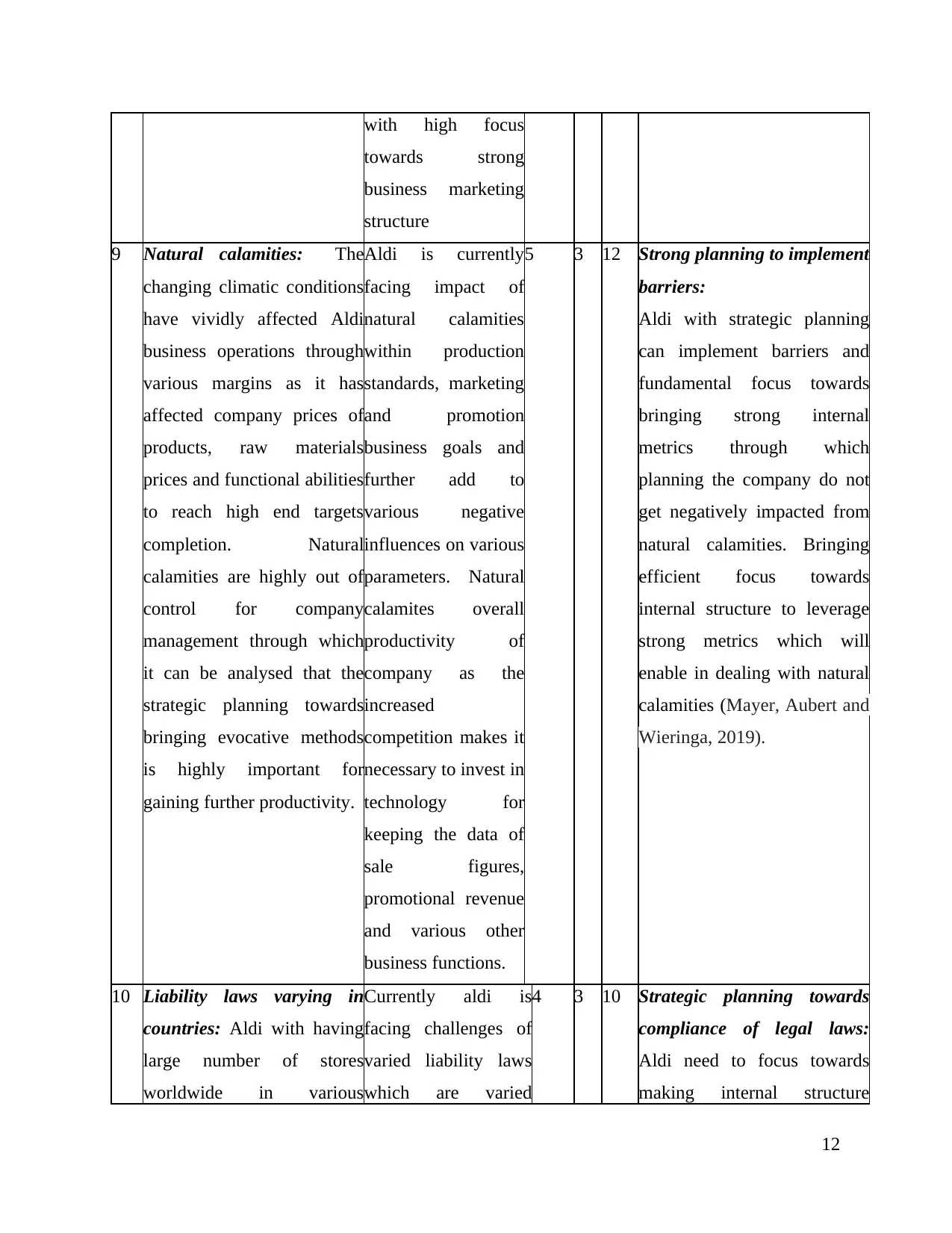
with high focus
towards strong
business marketing
structure
9 Natural calamities: The
changing climatic conditions
have vividly affected Aldi
business operations through
various margins as it has
affected company prices of
products, raw materials
prices and functional abilities
to reach high end targets
completion. Natural
calamities are highly out of
control for company
management through which
it can be analysed that the
strategic planning towards
bringing evocative methods
is highly important for
gaining further productivity.
Aldi is currently
facing impact of
natural calamities
within production
standards, marketing
and promotion
business goals and
further add to
various negative
influences on various
parameters. Natural
calamites overall
productivity of
company as the
increased
competition makes it
necessary to invest in
technology for
keeping the data of
sale figures,
promotional revenue
and various other
business functions.
5 3 12 Strong planning to implement
barriers:
Aldi with strategic planning
can implement barriers and
fundamental focus towards
bringing strong internal
metrics through which
planning the company do not
get negatively impacted from
natural calamities. Bringing
efficient focus towards
internal structure to leverage
strong metrics which will
enable in dealing with natural
calamities (Mayer, Aubert and
Wieringa, 2019).
10 Liability laws varying in
countries: Aldi with having
large number of stores
worldwide in various
Currently aldi is
facing challenges of
varied liability laws
which are varied
4 3 10 Strategic planning towards
compliance of legal laws:
Aldi need to focus towards
making internal structure
12
towards strong
business marketing
structure
9 Natural calamities: The
changing climatic conditions
have vividly affected Aldi
business operations through
various margins as it has
affected company prices of
products, raw materials
prices and functional abilities
to reach high end targets
completion. Natural
calamities are highly out of
control for company
management through which
it can be analysed that the
strategic planning towards
bringing evocative methods
is highly important for
gaining further productivity.
Aldi is currently
facing impact of
natural calamities
within production
standards, marketing
and promotion
business goals and
further add to
various negative
influences on various
parameters. Natural
calamites overall
productivity of
company as the
increased
competition makes it
necessary to invest in
technology for
keeping the data of
sale figures,
promotional revenue
and various other
business functions.
5 3 12 Strong planning to implement
barriers:
Aldi with strategic planning
can implement barriers and
fundamental focus towards
bringing strong internal
metrics through which
planning the company do not
get negatively impacted from
natural calamities. Bringing
efficient focus towards
internal structure to leverage
strong metrics which will
enable in dealing with natural
calamities (Mayer, Aubert and
Wieringa, 2019).
10 Liability laws varying in
countries: Aldi with having
large number of stores
worldwide in various
Currently aldi is
facing challenges of
varied liability laws
which are varied
4 3 10 Strategic planning towards
compliance of legal laws:
Aldi need to focus towards
making internal structure
12
⊘ This is a preview!⊘
Do you want full access?
Subscribe today to unlock all pages.

Trusted by 1+ million students worldwide
1 out of 16
Related Documents
Your All-in-One AI-Powered Toolkit for Academic Success.
+13062052269
info@desklib.com
Available 24*7 on WhatsApp / Email
![[object Object]](/_next/static/media/star-bottom.7253800d.svg)
Unlock your academic potential
Copyright © 2020–2025 A2Z Services. All Rights Reserved. Developed and managed by ZUCOL.





